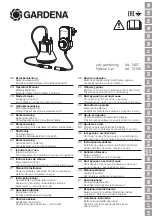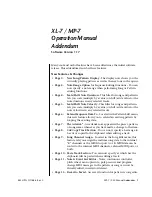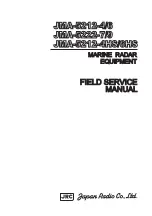
Page
81
of
133
Version 3.0 REV r000
Date 25-08-2010
The motion sensor should be mounted on as level a platform as possible. After mounting the
motion sensor, the actual 'mounting angles' should be measured. Some motion sensors contain
internal programs that can measure the mounting angles. Some data collection software packages
also include the capability to measure mounting angles. The mounting angles are the measured
degrees of the actual physical mounting of the motion sensor. This is to compensate for sloping or
warped decks. Many decks have some slope to them and this should be accounted for to ensure
that the pitch and roll values that the motion sensor derives is for vessel movement and not for its
physical mounting on the deck. The mounting angles should be measured prior to any multibeam
calibration and not changed after the calibration.
Prior to measuring the mounting angles, the vessel should be put in good trim by the engineer. On a
small vessel it is important that the angles be measured without undue influence from people
standing around. A false measurement can be induced by two people sitting on the gunwale having
a conversation while the measuring process is being completed. It is usually a good idea to have all
personnel leave a small vessel during the measuring process.
If the motion sensor mounting angles have been entered in the motion sensor or the data collection
software, they can only be changed prior to the multibeam calibration (patch test); they are not to
be changed after the patch test.
It is important to keep the motion sensor in mind when surveying. A motion sensor takes time to
'settle down' after a turn or a speed change and most of the settling down will depend on the heave
bandwidth that is entered into the motion sensor. Some motion sensors can take in position, speed
and heading data to assist them in the settling process. Depending on the degree of the turn or the
amount of the speed change a practical period of 2 minutes should be allowed for the motion
sensor to settle. It is prudent to plan the survey to allow for a long enough 'run in' to the start of
data collection to allow the motion sensor time to settle and the heave normalise. If this is not
done, many times motion artefacts or erroneous depths will be seen at the beginning of line and the
processed data will not be correct.
Monitor the motion sensor (all data collection software provides a time series window to monitor
individual data) to ensure that it is operating properly.
8.4
Sound Velocity Probes
There are two basic types of sound velocity probes. One type measures the parameters of sound
velocity in water; those being
C
onductivity (Salinity),
T
emperature, and
D
epth (Pressure), these are
normally referred to as CTD probes. The other type of probe contains a small transducer and has a
reflecting plate, at a known distance from the transducer that reflects the sound, the time is
measured for this transmission and the sound velocity determined by that measurement; these are
called Time of Flight probes. There is third type, known as the Expendable Bathythermograph (
XBT
)
which is launched and as it passes through the water column sends back temperature readings
(through two very thin wires); it is not recovered, it is expendable.
Содержание 2022
Страница 1: ...SONIC 2024 2022 BROADBAND MULTIBEAM ECHOSOUNDERS Operation Manual V3 0 Part No 96000001 ...
Страница 2: ...Page 2 of 133 Version 3 0 Rev r000 Date 25 08 2010 Part No 96000001 ...
Страница 28: ...Page 28 of 133 Version 3 0 Rev r000 Date 25 08 2010 Part No 96000001 This page intentionally left blank ...
Страница 70: ...Page 70 of 133 Version 3 0 Rev r000 Date 25 08 2010 Part No 96000001 This page intentionally left blank ...
Страница 72: ...Page 72 of 133 Version 3 0 Rev r000 Date 25 08 2010 Part No 96000001 This page intentionally left blank ...
Страница 92: ...Figure 78 Smooth log information copied from real time survey log ...
Страница 96: ...Page 96 of 133 Version 3 0 Rev r000 Date 25 08 2010 This page intentionally left blank ...
Страница 112: ...Page 112 of 133 Version 3 0 Rev r000 Date 25 08 2010 This page intentionally left blank ...
Страница 116: ...Page 116 of 133 Version 3 0 Rev r000 Date 25 08 2010 This page intentionally left blank ...
Страница 124: ...Page 124 of 133 Version 3 0 Rev r000 Date 25 08 2010 Part No 96000001 Figure 93 Sonic 2024 2022 Projector ...
Страница 125: ...Page 125 of 133 Version 3 0 REV r000 Date 25 08 2010 Figure 94 Sonic 2024 Receive Module ...
Страница 126: ...Page 126 of 133 Version 3 0 Rev r000 Date 25 08 2010 Part No 96000001 Figure 95 Sonic 2022 Receive Module ...
Страница 127: ...Page 127 of 133 Version 3 0 REV r000 Date 25 08 2010 Figure 96 Sonic 2024 Mounting Bracket Drawing 1 ...
Страница 128: ...Page 128 of 133 Version 3 0 Rev r000 Date 25 08 2010 Part No 96000001 Figure 97 Sonic 2024 Mounting Bracket Drawing 2 ...
Страница 129: ...Page 129 of 133 Version 3 0 REV r000 Date 25 08 2010 Figure 98 Sonic 2022 Mounting Bracket Drawing 1 ...
Страница 130: ...Page 130 of 133 Version 3 0 Rev r000 Date 25 08 2010 Part No 96000001 Figure 99 Sonic 2022 Mounting Bracket Drawing 2 ...
Страница 131: ...Page 131 of 133 Version 3 0 REV r000 Date 25 08 2010 Figure 100 Sonic 2024 2022 Mounting Bracket Flange ...
Страница 132: ...Page 132 of 133 Version 3 0 Rev r000 Date 25 08 2010 Part No 96000001 Figure 101 SIM Box Drawing ...
Страница 133: ...Page 133 of 133 Version 3 0 REV r000 Date 25 08 2010 Figure 102 R2Sonic Deck lead minimum connector passage dimensions ...
















































